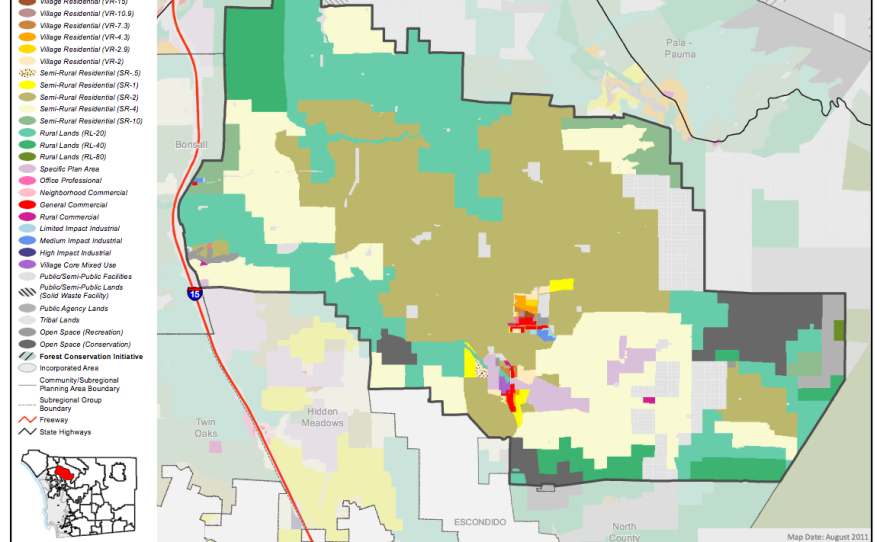The dilemma of where to build homes for San Diego’s growing population is at the heart of the proposed Lilac Hills Ranch development, or Measure B on the November ballot. Every voter in the county will have a say on the measure.
James Gordon lives on the edge of the 600 acres where Accretive Investments wants to develop a master-planned community. He is against the plan that would add 1,700 homes and 90,000 square feet of retail commercial space where just 110 homes are called for in San Diego County’s General Plan for growth.
There’s a reason, Gordon said, that the developer has gone to the expense of collecting signatures and putting this project on the ballot rather than going through normal channels: a vote from the county planning commission and the Board of Supervisors.
“They could have avoided all this money and just gone to the county Board of Supervisors,” Gordon said. “But they didn’t because they couldn’t. They couldn’t because the project wouldn’t be approved — and if it was approved, it would be approved with too many conditions.“
The project did go before the county planning commissioners, who voted 4-3 last fall to recommend approval, but only with conditions that would have cost the developer millions of dollars more. Then county Supervisor Bill Horn, who was expected to vote in favor of the project, chose to recuse himself because of a possible conflict of interest.
Measure B supporters
The Lilac Hills Ranch development has local supporters, many of whom live in communities on the other side of Interstate 15. Paul Schumann lives in Fallbrook and supports the initiative, calling its opponents NIMBYs.
“They’re just saying ‘no,’” Schumann said. “They’re saying ‘no’ to virtually every project that comes into the area that has to do with what’s in their backyard."
Schumann helped collect the signatures for the ballot measure. He said there’s no sham: the details are all in the 600-page initiative document. The development would be a sustainable master-planned community that has something for everyone, he said.
“The community, Lilac Hills Ranch, is perfect for a starter, for middle income, higher income and senior,” Schumann said. “So the entire community can stay together. I can have four generations of family together in the community and they will all feel like it’s their home.”
Schumann said voters all over the county understand the need for more housing.
“The voters for the first time will have a democratic process," Schumann said. "They will be able to look at the project and go, ‘That’s something the county needs.’”
Community planning
But it’s a democratic process that, in one day of voting, could overturn another sort of democratic process: years of community planning.

By putting the Lilac Hills initiative on the ballot, Accretive Investments effectively bypasses more than a decade of local planning. Valley Center’s plan calls for a 100 percent increase in homes between 2010 and 2050 — but not by West Lilac Road.
West Lilac is a winding two-lane country road, not wide enough to handle the 19,000 extra car trips a day the project would generate.
About 7 miles to the east, where the local community planning groups did call for more dense development, the county put in a new four-lane highway from Escondido up to Valley Center. It was completed in 2009 and runs right past where another developer, Kerry Garza, is working on a project of between 300 and 600 homes.
Development in line with the General Plan
“It was the perfect opportunity we saw to actually start the growth of Valley Center in the place they want it — in the core of the south village, and to be the developer that brings the community at large what they really want, a new town center in Valley Center,” Garza said.
Garza bought the land three years ago when a family dairy closed. He is not taking his project to the ballot because he expects to get approval within a year, going the normal route, through the county planning commission and the Board of Supervisors.
“Why would we have problems if we’re building exactly what they asked for, right?” Garza asked. “We’re building per the General Plan.”
Measure B supporter Schumann said Lilac Hills is also following the General Plan’s guidelines.
“What it calls out for is villages and communities. What are we building? A village community. We’re doing exactly what the General Plan said,” Schumann said.
But opponents call the project “leapfrog” development, something the General Plan specifically prohibited. Leapfrog development is placing a new development in rural areas where the infrastructure cannot support it.
“There’s no existing infrastructure out here,” Measure B opponent James Gordon said. “I am not quite sure about their theme of this happy little village. What they’re doing is they’re just taking a city the size of Del Mar, dropping it into a rural area that’s 30, 40 minutes round trip, just to get gas.”
Gordon said Accretive Investments bought the rural land cheaply precisely because it was not slated for development. He said the developer will leave county taxpayers and future homeowners to pick up millions of dollars for infrastructure like wider roads.
Voters face precedent-setting choice

“It shifts all of the liability of the substandard roads to the county,” Gordon said. He said it’s too easy for developers to put projects on the ballot if they encounter problems getting approval for their developments.
“It doesn’t matter whether you are in Chula Vista or National City or Rancho Santa Fe,” Gordon said. “What will happen if this is successful, it sets a precedent that’s disastrous for this county.”
The unincorporated, semi-rural backcountry offers tempting open space for more development. But voters will have to weigh the need for new construction with the precedent that this initiative could set for bypassing the will of local communities anywhere in the county.






